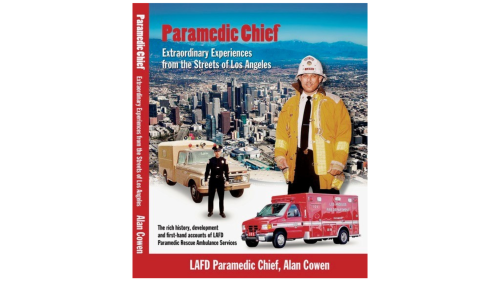The following content is part of EMS1’s EMS Leader Playbook – aimed at helping new EMS leaders increase their effectiveness, enhance their leadership KSAs, develop trust among crewmembers, and build confidence. Through a handful of questions presented by EMS1, veteran chiefs reflect on their early days in leadership roles and offer advice, while newer leaders detail their experiences taking on a new position.
Email editor@ems1.com to offer your insights for the EMS Leader Playbook or to nominate a chief to be featured.
In this installment of Chief Insights, we feature Alan Cowen, fire deputy chief (ret.) Los Angeles City Fire Department.
What was the incident or person in your career that put you on the path to becoming a chief?
When I was 10 years old (1955) I was playing outside, and the ground began to shake, my dog’s ears perked up and I knew in a nanosecond that a train had struck something in Culver City where I lived. I ran as fast as I could while hearing a distant siren of a fire engine approaching; I wanted to race to the scene and arrive first. The same morbid curiosity that causes people to stop at a crash site, carried me along too. In fact, a train had crashed into a car and bystanders were hysterical and it was the first time I witnessed adults emotionally out of control.
After the EMS crew of the LA Emergency Medical Ambulance System arrived, the ambulance driver saw a hysterical woman and snapped his finger and stated, “everything is going to be okay, let’s take one thing at a time.” From that moment on I wanted to be just like the rescuers. Eight years later, I was in college working on an ambulance. Thirty-two years later, I found myself the Paramedic Chief and Commander of the Emergency Medical Services Bureau of the Los Angeles Fire Department.
How do you create an organizational culture that people want to be a part of, to join and to stay?
While Chief of the EMS Bureau, I fostered a sense of professionalism and managed by “walking around.” I would respond to many emergencies and when appropriate I would complement the men and women of the LAFD, when they performed admirably. I also had an open-door policy and was available to every single member of my command. They knew I could be depended upon to help them in any way feasible. I was a motivator and would encourage them to be their best.
How do you support and stand up for your personnel, internally and externally, to show that you care about them as a person and a professional?
I’ve always supported my personnel by treating them with absolute respect, and in turn, they did their best for me. I demanded that they do their best work while on their tour of duty. When necessary, I would offer additional training and when needed, remedial training. There are times when violations of the rules and regulations of the fire department occur, and corrective action is needed and will be required. Respect is earned not automatic.
How do you demonstrate servant leadership?
There were many times, such as during the 1992 LA Riots, that we put together committees of field paramedics to address dangerous situations in the field setting. The purpose was to have short-term and long-term goals and objectives, such as safety for our firefighters and paramedics. An example would be short-term and no- or low-cost suggestions on safety of our personnel and the public. Specific examples included body armor for first responders, which were required when entering dangerous situations like shootings, stabbings, hostage situations and domestic violence calls for help. These suggestions were not shelved but carried out immediately. By having the people in the field setting come together for the benefit of everyone.
Leadership lightning round
What is a leadership book, podcast or seminar you’ve found invaluable?
Back in 1980s and 1990s I orchestrated, in coordination with Northridge Hospital, a seminar that dealt with potential emergencies such as preparing for the Africanized honeybees in preparation for the arrival. Additionally, a guest speaker was brought in from the Coroner’s Office to increase education of the handing of dead bodies.
If you knew the budget request would be approved, what’s a big purchase you’d make for your department today?
Some of the biggest budget requests were obtained during the AIDS Epidemic. It was special IV needles that would not stick first responders accidentally, and as noted above, body armor which cost over many thousands of dollars to protect our first responders. Although I am retired now, in today’s world, I would add an additional 50 paramedic ambulances to our department.
How do you recharge/improve your resiliency?
As far as resiliency is concerned, we had and continue to have debriefings with specialized personnel headed by a group of psychologists available to all members as needed. At any incident, the incident commander can request psychologists to respond to the scene or the fire station for additional help.








